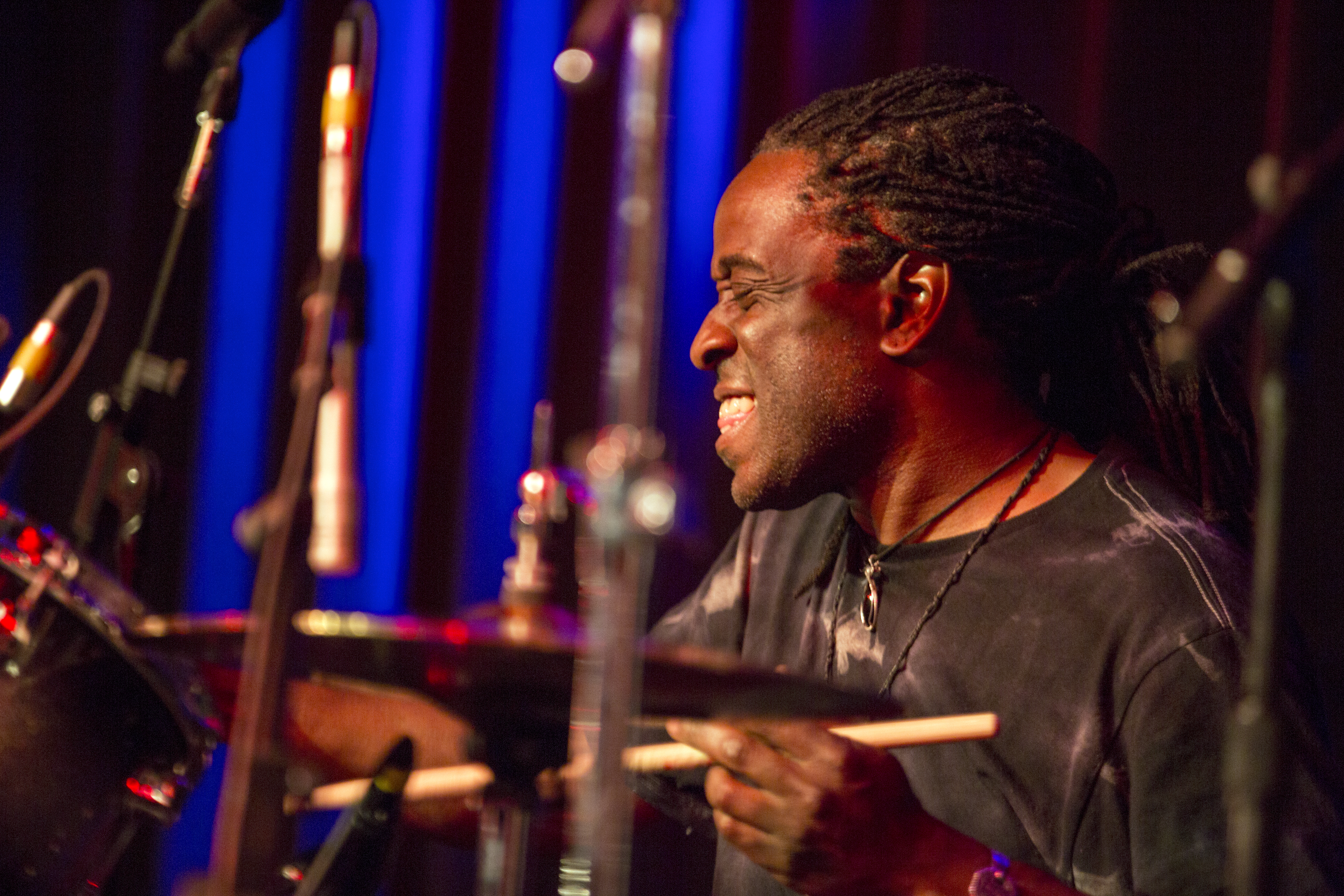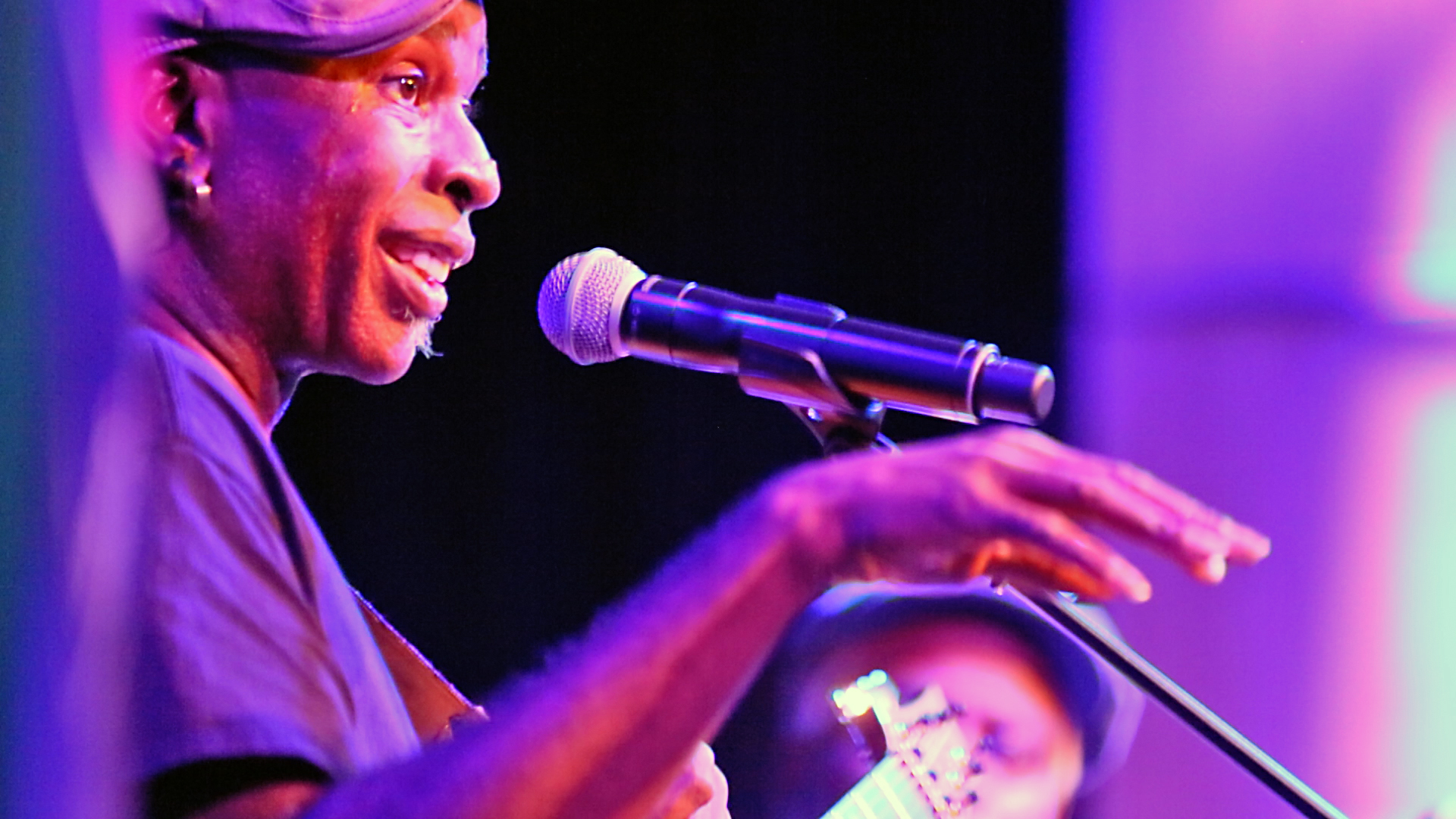Living Colour and Drummer Will Calhoun '86 on Fire at Berklee
As the last notes of their iconic song "Cult of Personality" rang throughout David Friend Recital Hall—at the conclusion of Living Colour's searing three-song set and master class—so too did the sounding alarm of a scheduled fire drill. "They're on fire!" quipped the emcee, a representative from D'Addario, who cohosted the performance and subsequent instrumental clinics from the venerable titans of rock, as students and fans began their exit.
For drummer Will Calhoun '86, a driving force behind the kit with Living Colour over the past 30 years, viewing one of the world's earliest instruments and communication devices from a global and historical perspective is as important as developing one's craft.
During the master class, he shared advice and stories from the road. The following are excerpts from Calhoun's presentation.
Will Calhoun: Rhythmic Ambience Director
I changed my business card to Will Calhoun: Rhythmic Ambience Director. Spiritually and mentally, I'm trying to incorporate all of those things into the drum set. This is pretty much a new instrument in terms of the technology of drumming. The djembes and the sabars and the Batás and these other instruments are very, very old. Part of my studying is to bring some of those things to the kit, which is a more modern instrument—cymbals and hi hat stand and so on.
I have some friends who play symphony music. I have friends who play punk, metal, rap, whatever. It's all to me sound and rhythm. Some nights I go to clubs and just sit next to the DJ and watch what tempos he’s playing to what the crowd reacts to, because I want to know what they’re moving to, what’s making them groove. So when I’m playing, I know how to get people going. So you have to learn the antiques, the indigenous things, in my opinion; you have to learn the academics of the instrument, and you also have to learn what’s happening now, what’s present with the instrument. And it’s the same thing with your career.
A Changing Landscape
No matter what your situation is, one of the most attractive things for me about Living Colour was the independence of the band. No matter what was happening with the industry—MTV was blowing up around that time— we were independent. We made the music, we wanted to make the music, we dressed the way we wanted to dress; the lyrics [and] the content [were] about our ideas.
Whatever is going on in the industry, don’t lose yourself in your journey. If your thing is metal, or punk, or rap, whatever it is and that's your thing, be that thing, create that art that you really feel. You're in this seat now; I was in that seat at one time, coming to clinics and watching cats come to school and talk about the same thing, and it made me independent while I was in Berklee. One of the things I want to stress—whatever is going on, whether with a record label or online—keep your character and your art the way you feel is honest, the way you honestly feel you want to portray it. That is very important, because in the universities sometimes, or even at a label, you can tend to give that up and go along to get along. As an artist, you will just suffer later on down the line.
On Developing Musicality and a Foray into Asian Flutes
How did I develop my musicality? A lot of ways. One of them is with this gentleman over here, Lenny Nelson, who is a local Boston drum master that I studied with. He still sends me very difficult CDs to practice. And I studied also with a gentleman here, Kenwood Dennard, a fantastic drummer as well. I developed the musicality by listening to music, and not approaching my drum set like a caveman and just thinking about time and sound. The drum set is a musical instrument. It has pitches and tones, and tonalities.
Musicality comes from being musical, and listening to other instruments closely. I'm playing a lot of Asian flutes now, because I was on tour with Pharoah Sanders and we went to this rural music shop, and went to the drum section, and Pharoah said, “Why do you always go to the drum section? Go find an instrument you can’t spell, don’t know how to pronounce, and buy it and learn how to play it.” So I bought this Chinese flute, and then he gave me some breathing exercises, and in a year I was playing some tunes, and I went back and bought two or three more, and now I have 10 of them in different keys. I’m digging it, and Pharoah’s correct. Now when I go back to my instrument, I have another vocabulary. I have another alphabet to put into that set.
Living History
I've been going to mostly West and North Africa for the last 15 years, studying a lot of master musicians, Gnawa musicians in Morocco; all of this music that really should be in the universities and schools. I’m going to try to help make that happen. Some of those beats are 40,000 years old, if you can imagine that. The stuff's passed down, and the beats were not for entertainment; it was for things like harvesting and rain, helping pregnancies, and for war. So the vibrations of the drum and those rhythms create a certain kind of reaction in people—even for healing. A lot of the bush medicine doctors always have the drummer or somebody play before they come in to heal you because your vibration has to be in the right place—which is what music is about, in a more modern sense.
My message is you have to think globally with the instrument. That's the best advice I can give you. Technology: know it, get familiar with it. But what’s more important is the history of the instrument and where it comes from, and you knowing that.




